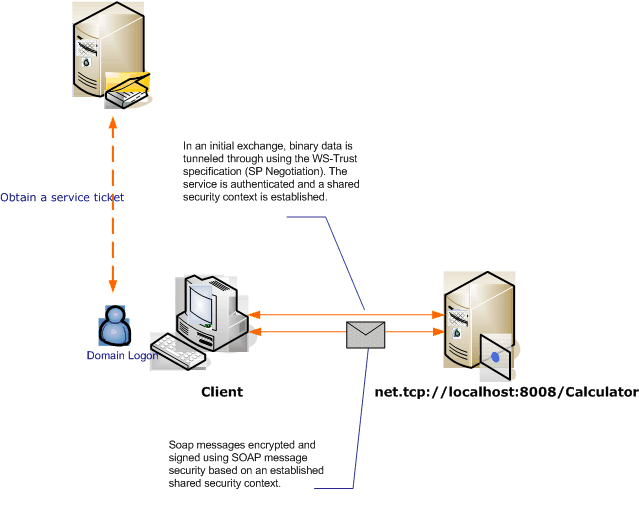Meddelandesäkerhet med en Windows-klient
Det här scenariot visar en WCF-klient (Windows Communication Foundation) som skyddas av meddelandesäkerhetsläget. Klienten och tjänsten autentiseras med Windows-autentiseringsuppgifter.

| Characteristic | beskrivning |
|---|---|
| Säkerhetsläge | Meddelande |
| Samverkan | Endast WCF |
| Autentisering (server) | Ömsesidig autentisering av servern och klienten |
| Autentisering (klient) | Ömsesidig autentisering av servern och klienten |
| Integritet | Ja, med hjälp av delad säkerhetskontext |
| Sekretess | Ja, med hjälp av delad säkerhetskontext |
| Transport | NET. TCP |
| Bindning | NetTcpBinding |
Tjänst
Följande kod och konfiguration är avsedda att köras oberoende av varandra. Gör något av följande:
Skapa en fristående tjänst med hjälp av koden utan konfiguration.
Skapa en tjänst med den angivna konfigurationen, men definiera inga slutpunkter.
Kod
Följande kod visar hur du skapar en tjänstslutpunkt som använder meddelandesäkerhet för att upprätta en säker kontext med en Windows-dator.
// Create the binding.
NetTcpBinding binding = new NetTcpBinding();
binding.Security.Mode = SecurityMode.Message;
binding.Security.Message.ClientCredentialType =
MessageCredentialType.Windows;
// Create the URI for the endpoint.
Uri netTcpUri = new Uri("net.tcp://localhost:8008/Calculator");
// Crate the service host and add an endpoint.
ServiceHost myServiceHost = new ServiceHost
(typeof(Calculator), netTcpUri);
myServiceHost.AddServiceEndpoint(
typeof(ICalculator), binding, "");
// Open the service.
myServiceHost.Open();
Console.WriteLine("Listening ....");
Console.ReadLine();
// Close the service.
myServiceHost.Close();
' Create the binding.
Dim binding As New NetTcpBinding()
binding.Security.Mode = SecurityMode.Message
binding.Security.Message.ClientCredentialType = MessageCredentialType.Windows
' Create the URI for the endpoint.
Dim netTcpUri As New Uri("net.tcp://localhost:8008/Calculator")
' Crate the service host and add an endpoint.
Dim myServiceHost As New ServiceHost(GetType(ServiceModel.Calculator), netTcpUri)
myServiceHost.AddServiceEndpoint(GetType(ICalculator), binding, "")
' Open the service.
myServiceHost.Open()
Console.WriteLine("Listening ....")
Console.ReadLine()
' Close the service.
myServiceHost.Close()
Konfiguration
Följande konfiguration kan användas i stället för koden för att konfigurera tjänsten:
<?xml version="1.0" encoding="utf-8"?>
<configuration>
<system.serviceModel>
<services>
<service behaviorConfiguration=""
name="ServiceModel.Calculator">
<endpoint address="net.tcp://localhost:8008/Calculator"
binding="netTcpBinding"
bindingConfiguration="Windows"
name="WindowsOverMessage"
contract="ServiceModel.ICalculator" />
</service>
</services>
<bindings>
<netTcpBinding>
<binding name="Windows">
<security mode="Message">
<message clientCredentialType="Windows" />
</security>
</binding>
</netTcpBinding>
</bindings>
<client />
</system.serviceModel>
</configuration>
Klient
Följande kod och konfiguration är avsedda att köras oberoende av varandra. Gör något av följande:
Skapa en fristående klient med hjälp av koden (och klientkoden).
Skapa en klient som inte definierar några slutpunktsadresser. Använd i stället klientkonstruktorn som tar konfigurationsnamnet som argument. Till exempel:
CalculatorClient cc = new CalculatorClient("EndpointConfigurationName");Dim cc As New CalculatorClient("EndpointConfigurationName")
Kod
Följande kod skapar en klient. Bindningen är till Meddelandelägessäkerhet och klientens autentiseringstyp är inställd på Windows.
// Create the binding.
NetTcpBinding myBinding = new NetTcpBinding();
myBinding.Security.Mode = SecurityMode.Message;
myBinding.Security.Message.ClientCredentialType =
MessageCredentialType.Windows;
// Create the endpoint address.
EndpointAddress ea = new
EndpointAddress("net.tcp://machineName:8008/Calculator");
// Create the client.
CalculatorClient cc =
new CalculatorClient(myBinding, ea);
// Begin using the client.
try
{
cc.Open();
Console.WriteLine(cc.Add(200, 1111));
Console.ReadLine();
// Close the client.
cc.Close();
}
' Create the binding.
Dim myBinding As New NetTcpBinding()
myBinding.Security.Mode = SecurityMode.Message
myBinding.Security.Message.ClientCredentialType = MessageCredentialType.Windows
' Create the endpoint address.
Dim ea As New EndpointAddress("net.tcp://machineName:8008/Calculator")
' Create the client.
Dim cc As New CalculatorClient(myBinding, ea)
' Begin using the client.
Try
cc.Open()
Console.WriteLine(cc.Add(100, 11))
Console.ReadLine()
' Close the client.
cc.Close()
Catch tex As TimeoutException
Console.WriteLine(tex.Message)
cc.Abort()
Catch cex As CommunicationException
Console.WriteLine(cex.Message)
cc.Abort()
Finally
Console.WriteLine("Closed the client")
Console.ReadLine()
End Try
Konfiguration
Följande konfiguration används för att ange klientegenskaperna.
<?xml version="1.0" encoding="utf-8"?>
<configuration>
<system.serviceModel>
<bindings>
<netTcpBinding>
<binding name="NetTcpBinding_ICalculator" >
<security mode="Message">
<message clientCredentialType="Windows" />
</security>
</binding>
</netTcpBinding>
</bindings>
<client>
<endpoint address="net.tcp://machineName:8008/Calculator"
binding="netTcpBinding"
bindingConfiguration="NetTcpBinding_ICalculator"
contract="ICalculator"
name="NetTcpBinding_ICalculator">
</endpoint>
</client>
</system.serviceModel>
</configuration>